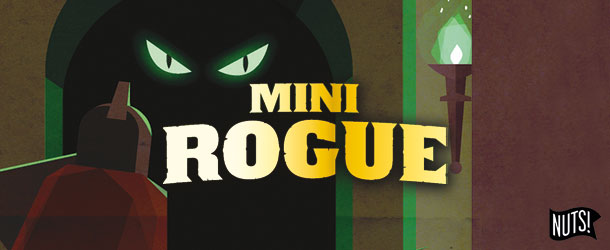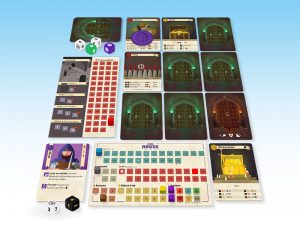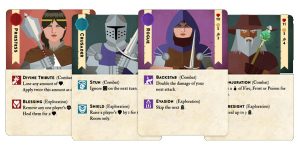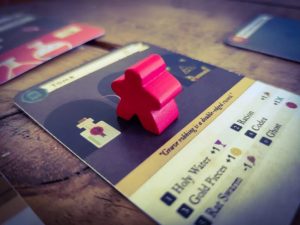Mini Rogue, the minimalist dungeon crawler, is an engaging solitaire or co-operative game. One or two players take the role of adventurers delving into a dungeon, room after room, area after area, floor after floor, to find the Og's Blood: a fabled and mysterious artifact said to be a ruby gemstone. The game takes seconds to set up and makes for quick, tense dungeon romps.
Players choose a character - Mage, Rogue, Priestess, or Crusader, each one with unique skills. For players who love challenges, Mini Rogue allows to set the difficulty level, applying a handicap on the chosen character's starting stats. There are three optional difficulty levels - Hard, Harder, and Nightmare. For example, the hardest difficulty level, Nightmare, removes 1 Food, 2 HP, and 3 Gold from the starting stats.
Some characters have skills that have interesting trade-offs, like the Priestess` Divine Tribute skill: pay any amount of HP and apply twice that amount as damage to a Monster. As powerful as it is, it can be dangerous to use.
The dungeon area is laid out as a grid of room cards. Each time players face two rooms, and have to choose and explore one. In each room, they may encounter a monster, find a treasure, discover a resting area, dodge traps, or face many other surprising encounters.
Mainly a solo game, Mini Rogue can also be played with another player or in solitaire mode with one player controlling two characters, using the co-operative rules.
To play in cooperative mode, each player chooses a Character and manages their own resources. A player is designated as the Party Leader (aka. the first player). This role will alternate at each Area.
Each player controls their own character, starting in the entrance Room of an Area, and then resolving the entrance Room card, one after the other, starting with the Party Leader. After the first Room card is resolved by both players (this means resolving the same Room card may have different outcomes for each player), they are free to choose to move to different Room cards. They'll always both reunite at the Exit and perform the Delving Phase together.
Having both players explore different Rooms of the dungeon is compelling because:
- It replicates the feel of fully-fledged dungeon crawlers where players may go explore different parts.
- It quickly creates asymmetry in the character's stats and resources. It is imperative to keep both characters alive to win as the death of a character results in failure. The game is already difficult, having to worry about the survival of the partner increases the challenge.
- It encourages players to take different risks and paths based on their Skills and their current stats.
When players enter in Combat together, the Monster's HP pool is doubled:
- This accounts for the fact that the Monster now has two Characters attacking (double the HP pool too!), this way all combats are scaled and balanced in terms of difficulty.
- It's also interesting as players now have two different Combat Skills at their disposal for handling a Monster. However, there's a catch since the HP pool is doubled: when two players decide to enter combat together, they should make sure both are in a good position to quickly dispose of the monster and survive!
When players are together in the same Room, they may trade or give any number of items, respecting the inventory limit at the end of the trade. Consider how this makes it quite strategic in terms of how they may choose to split up, find an item useful for the other character (e.g. a healing potion) and now must regroup to trade the potion. Or consider this: both players only have 2 Gold but they decide to regroup at the merchant, put their money together, sell a potion, and all of a sudden, they're able to afford an armor piece for an under-equipped Adventurer.
This goes to show that with a few simple rules, it was possible to create another layer of strategic and tactical decisions that weren't readily apparent upon just reading the rules.
Campaign Mode
The Monsters, the Traps, and other Room cards evolve with the dungeon depth to keep the challenge interesting and to scale their power with the players’. The campaign mode also brings some hard challenges.
In Mini Rogue's Campaign mode, the player reads through small Story Chapters that reveal the background story of this forsaken place. After each Story Chapter, narrative choices are given and sometimes unique items or conditions to fulfill for the next dungeon run. Once a dungeon run ends (either in failure or in an unlikely success), the player will continue to a new Chapter. It will have multiple branching paths and Chapters that will make this small campaign replayable.
In between dungeon runs, the player will unlock Perk points based on its score. These perk points will unlock permanent abilities on a Skill Tree. This will add permanent character building to the game, but with restrictions on the number of perks a player may unlock based on the skill tree's branching to keep it balanced and challenging.
The skill tree features three main paths: Exploration perks, Survival perks, and Combat perks. Exploration perks allow the character to be Nimbler for exploration and have Sharper Eyes for finding valuables. The Survival perks make the character less likely to die: it may unlock Hunting abilities or become a better Healer. Lastly, there are Combat perks, these will turn the adventurer into a deadly combatant: it'll have plenty of Resolve and use less energy to perform re-rolls (aka. Feats) and you'll become better at defending against Critical Hits from the monsters.
For more details about how to play Mini Rogue, the rulebook is available for download.













